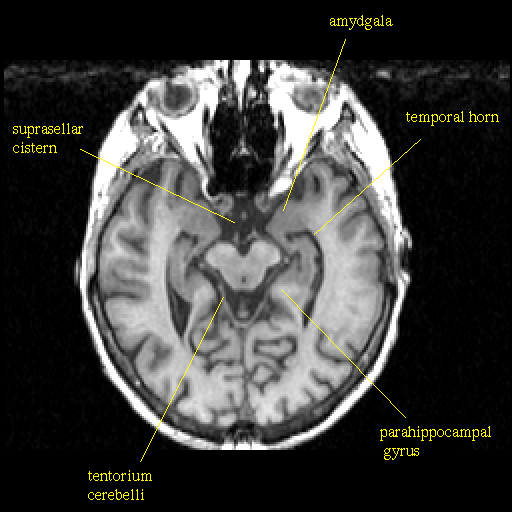Table of Contents
Temporal horn
 The temporal horn of the lateral ventricle (inferior horn, descending horn; middle horn; medicornu), is the largest of the horns of the lateral ventricle, traverses the temporal lobe of the brain, forming in its course a curve around the posterior end of the thalamus.
The temporal horn of the lateral ventricle (inferior horn, descending horn; middle horn; medicornu), is the largest of the horns of the lateral ventricle, traverses the temporal lobe of the brain, forming in its course a curve around the posterior end of the thalamus.
It passes at first backward, lateralward, and downward, and then curves forward to within 2.5 cm. of the apex of the temporal lobe, its direction being fairly well indicated on the surface of the brain by that of the superior temporal sulcus.
Its roof is formed chiefly by the inferior surface of the tapetum of the corpus callosum, but the tail of the caudate nucleus and the stria terminalis also extend forward in the roof of the temporal horn to its extremity; the tail of the caudate nucleus joins the putamen.
Its floor presents the following parts: the hippocampus, the fimbria hippocampi, the collateral eminence, and the choroid plexus.
When the choroid plexus is removed, a cleft-like opening is left along the medial wall of the temporal horn; this cleft constitutes the lower part of the choroidal fissure.
Dimensions
The temporal horn of the lateral ventricle has been reported to be approximately 3.97–4.08 cm long 1). Tubbs et al. found that this distance had a wider range of 2.5–6.5 cm. Many have assumed that the temporal horn, which extends from the atrium into the medial part of the temporal lobe, is deep to the middle temporal gyrus and begins approximately 4 cm from the anterior pole of the temporal lobe 2) 3). However, Tubbs et al. found that this range is wider and that the inferior temporal sulcus is a better landmark for this deeper lying cavity.
Landmarks
The location of the temporal horn is important to neurosurgeons during procedures such as amygdalohippocampectomy and intraventricular electrode placement for temporal lobe seizure monitoring. However, sometimes the temporal horn is difficult to localize, especially without neuronavigation.
The cortical projection of the inferior choroidal point (ICP) is a reliable landmark for reaching the temporal horn 4).